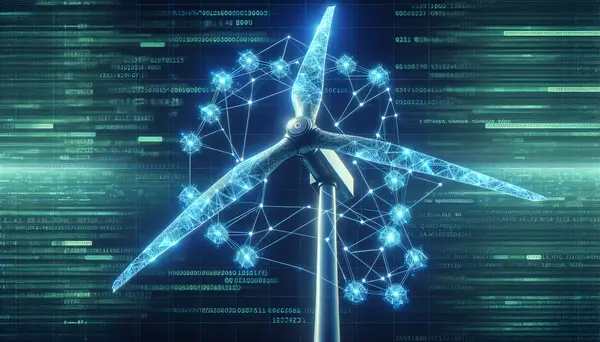Introduction: Unveiling Blockchain and Renewable Energy
As we continue to explore ways to create a sustainable future, two distinct but potentially harmonious concepts have emerged: Blockchain technology and renewable energy. As the digital revolution continues to change our lives in numerous ways, we are constantly seeking new solutions that can drive us towards a more sustainable and energy-efficient future. In this context, the role of Blockchain, famous for powering cryptocurrencies, in transforming renewable energy makes for an intriguing discourse.
The Blockchain technology, a decentralized public ledger system with transparent and secure transaction validation, has the capacity to reshape multiple sectors, including the financial and energy industries. With the ability to promote decentralization, transparency, and peer-to-peer transactions, Blockchain has extraordinary potential when aligned with renewable energy production and distribution.
The Best Mining Providers at a Glance
» Infinity HashFrom our perspective, currently the best mining provider on the market. With the community concept, you participate in a mining pool completely managed by professionals. A portion of the earnings are used for expansion and maintenance. We've never seen this solved as cleanly anywhere else.
» Hashing24A well-known and established cloud hosting company. With a good entry point and in a good market phase, a good ROI can also be generated with some patience. Unfortunately, we see the durations as a major drawback.
Renewable energy, harnessed from sustainable sources like the sun, wind, and water, is pivotal to mitigating climate change and reducing our reliance on fossil fuels. But its integration into our energy systems has been slow and inconsistent, largely due to infrastructural and financial challenges.
This article explores the role of Blockchain in renewable energy and assesses whether the promise of a perfect match is genuine or mere hype. By understanding the fundamentals of both Blockchain and renewable energy, we can delve deeper into their prospective synergy and significance in the progression towards global sustainability.
The Concept of Blockchain Explained
The term Blockchain became well-known with the rise of the digital currency, Bitcoin. However, its utility extends far beyond the realm of cryptocurrency. It is essentially a digital ledger, akin to an infinite spreadsheet in which each transaction made is recorded chronologically and publicly. These transactions, once validated, are bundled into blocks and chained together in a linear sequential order, thus the name "Blockchain".
In contrast to traditional databases where records are stored in a centralized location, the Blockchain structure is inherently decentralized and distributed across a network of computers, ensuring no single point of failure. This decentralization is facilitated through a consensus mechanism that requires network participant, or 'nodes', to validate each transaction. Once validated, the transaction becomes indelible and tamper-proof, ensuring the integrity of the records.
Moreover, Blockchain's transparency level grants every participant the ability to observe and audit the chain of transactions in real-time. These inherent characteristics of security, immutability and transparency make Blockchain a compelling choice for a wide range of applications, including improving the renewable energy sector.
Advantages and Disadvantages of Blockchain in Renewable Energy
| Pros | Cons |
|---|---|
| Reduces operational inefficiencies and costs | Requires a significant investment to implement |
| Increases transparency in energy transactions | It's a technology still under development with regulatory issues |
| Creates decentralized energy markets | It's energy consumption is high, contradicting its use for green purposes |
| Enables peer-to-peer energy trading | Security concerns over grid vulnerability to cyber attacks |
| Facilitates integration of renewable energy sources | Lack of awareness and understanding of the technology |
How Renewable Energy Works

The term 'renewable energy' refers to energy that is derived from natural sources which replenish themselves over time, such as sunlight, wind, rain, tides, and geothermal heat. These energy sources are inexhaustible and constantly renewed. Renewable energy holds an integral role in reducing greenhouse gas emissions and diversifying energy supplies.
Renewable energy is tapped using technologies that range from solar power, wind power, hydroelectric power, tidal power and geothermal energy to bioenergy. These technologies convert natural resources into usable forms of energy, most often electricity. For instance, solar panels harness the energy from the sun and convert it into electrical energy that can be used to power homes, offices, and industrial facilities.
Solar and wind energy collection, in particular, are known for their variability. As these energy sources are weather-dependent, they are not always available consistently. This fact, combined with traditional power grid structures, designed for large, centralized energy production, creates challenges for the large-scale implementation of renewable energy.
Nevertheless, technologies like energy storage and smarter grid systems are being developed to make renewable energy use more predictable and manageable. Despite the challenges and higher upfront costs, investment in renewable energy continues to increase globally, aligning with our global need for sustainable energy solutions.
Blockchain and Renewable Energy: The Perfect Harmony
The ongoing fusion of Blockchain technology and renewable energy heralds a transformative era for the energy sector. While each domain has its separate benefits, together they have the potential to address several pain points in our energy systems, leading us towards a more sustainable future.
Blockchain technology's decentralized nature complements the distributed nature of renewable energy resources. Where traditional energy grids have centralized production hubs, Blockchain allows for decentralized energy production and consumption. Solar and wind farms can put power on the grid, and individual households can sell excess power from their solar panels directly to their neighbors, all under a secure, transparent, and efficient system facilitated by Blockchain. This not only improves energy distribution but also creates potential for new economic models such as peer-to-peer energy trading.
One fundamental issue with renewable energy is securing investments and funding due to uncertainties surrounding return on investment. Blockchain can play a significant role in scaling up investments in renewables by creating a traceable, secure, and transparent path for cash flows, providing potential investors with the confidence they need.
Moreover, Blockchain can contribute immensely to manage the intermittency associated with renewable energy production. Smart Contracts, a crucial feature of Blockchain, can be leveraged to automate transactions based on predetermined terms. For instance, a Smart Contract could automatically initiate energy transfers or payments when the Renewable Energy Certificate (REC) is produced or sold.
Lastly, the transparency ingrained in Blockchain could heighten consumer trust in renewable energy. With Blockchain, energy consumers have the ability to trace the green energy source they are purchasing, fostering a more authentic connection to renewable energy practices, and promoting a global shift towards cleaner, more responsible energy consumption.
Real-World Examples of the Blockchain in Renewable Energy

Seeing the potential of Blockchain in facilitating renewable energy, numerous real-world implementations are underway. Below are a few exciting examples illustrating Blockchain’s footprint in the renewable energy landscape.
Power Ledger, an Australian-based technology company, launched a revolutionary peer-to-peer (P2P) energy trading platform powered by Blockchain. This platform allows individuals and businesses to sell the surplus renewable energy they generate to their neighbours. The transaction is transparent, automated, and does not require a middleman, resulting in a fair and efficient trading ecosystem.
The Brooklyn-based project LO3 Energy has created a local energy market by using Blockchain. With LO3 Energy's platform, residents can buy and sell locally produced solar energy. By having a decentralized network, consumers have the choice and control over their energy source.
Another case is WePower, a Lithuanian green energy trading platform. WePower uses Blockchain to facilitate renewable energy investments and trading. They offer a platform where green energy producers can raise capital by selling energy upfront to consumers, thus providing a win-win scenario for both parties.
Projects like these underscore the capacity of Blockchain to redefine our interaction with energy, driving us closer to a decentralized and sustainable energy future.
The Potential Challenges of Blockchain in the Energy Sector
While the synergies between Blockchain and renewable energy are clear, potential challenges could slow down or complicate their fusion. The energy industry, deeply ingrained with legacy infrastructure and processes, may be resistant to adopting a fundamentally new approach like Blockchain. Interoperability issues may also arise when trying to integrate Blockchain with existing energy systems and infrastructure.
In addition, the regulatory landscape could also pose a challenge. Regulations for both the Blockchain and energy markets vary widely between different countries and regions, possibly hindering a smooth adoption process. Also, Blockchain's public perception, predominantly formed by its association with controversial cryptocurrencies like Bitcoin, may affect its acceptance in the energy sector.
Additionally, the technical constraints of Blockchain cannot be ignored. The significant energy consumption of public Blockchain networks, inconvenient particularly for an industry focused on reducing its carbon footprint, must be addressed. Other technical concerns include issues of scaling, transaction speed, and the security of smart contracts.
Despite these challenges, the potential benefits of integrating Blockchain into renewable energy systems should encourage exploration and innovation in this space. With continued research and the right regulatory support, Blockchain could push the renewable energy sector into unprecedented levels of efficiency, transparency, and sustainability.
The Future of Blockchain and Renewable Energy

As we move toward a future where sustainability and digitalization shape our world, the integration of renewable energy and Blockchain technology presents an exciting prospect. These two innovative elements are predicted to revolutionize the energy sector and how we perceive energy consumption and distribution. With the rise of microgrids and increasing adoption of distributed energy resources, Blockchain could pave the way for a democratized energy system where consumers become prosumers - producing, consuming and selling their own renewable energy.
This shift could ignite a significant change in the energy sector, breaking the monopoly of traditional utility companies and empowering individuals and communities with clean, affordable, and reliable renewable energy. Implementing this vision, however, relies heavily on technological advancement, regulatory adaptation, and public acceptance. Widespread adoption of Blockchain in renewable energy will need clear regulations that promote transparency and trust while ensuring security.
In the end, the future of Blockchain and renewable energy relies on their ability to work synergistically. Collaborative efforts are required from stakeholders, technologists, policymakers, and consumers. By overcoming challenges and exploiting potential benefits, both Blockchain and renewable energy can initiate a new era characterized by decentralization, democratization, and sustainability in the energy sector. Cryptocurrencies, such as Bitcoin, might have introduced us to Blockchain, but it could be the green energy sector that truly showcases its revolutionary potential.
Conclusion – A Potent Union for Sustainable Energy and Beyond
In conclusion, the potential for the collaboration of Blockchain technology and renewable energy presents a powerful solution for the future of energy systems worldwide. With ongoing advancements and keen investment, this powerful duo could redefine our perception of the energy landscape, enabling a shift from a centralised model to one that is decentralized, transparent, and participatory. This potent union could democratize access to energy, promote peer-to-peer energy trading, encourage green energy production, and enhance transparency in the energy sector.
While this "perfect match" is still in its nascent stage, it nonetheless holds promise. With continuous research, regulation and adoption, Blockchain and renewable energy could catalyse a sustainable and robust energy future. As this Blockchain-infused renewable energy revolution unfolds, its impact could reach far beyond the energy sector, offering immeasurable societal and environmental benefits.
Conclusion: Blockchain's Role in Pushing Renewable Energy Forward
As we reach the concluding remarks, it's soon evident that the pairing of Blockchain technology and renewable energy isn’t just a fleeting trend. Instead, their symbiotic relationship could be a crucial step towards transforming energy markets towards decentralisation and full transparency.
The potential applications of Blockchain in the renewable energy sector are vast and varied, ranging from peer-to-peer energy trading to renewable energy certificates. Not only does this interfere with our traditional understanding of energy production and consumption, but it also empowers consumers by providing them more control over their energy sources and usage.
Meanwhile, the renewable energy sector can also benefit from increased efficiency, reduced operational costs, and streamlined regulatory compliance that Blockchain can offer. The lowering of barriers to entry and increased market competitiveness will see a surge in the democratization of energy.
However, the road to proper integration is not wholly smooth and laden with challenges such as regulatory barriers, scalability issues, and the need for technological enhancements. Yet, despite the hurdles, the transformative potential of this progressive amalgamation is undeniable.
With our planet's fate hanging in the balance, the marriage of Blockchain technology and renewable energy could very well be the lifeline we need for a sustainable future. Thus, while navigating the path and overcoming anticipated challenges may prove somewhat complex, the end game—an energy efficient, environmentally friendly and sustainable future—is undoubtedly worth it.
Frequently Asked Questions about Blockchain and Renewable Energy
How does blockchain support renewable energy?
Blockchain can enable peer-to-peer energy trading, it helps in recording energy data, and can also provide a secure platform for documenting renewable energy certificates.
What is peer-to-peer energy trading?
Peer-to-peer energy trading is a concept where individuals can buy and sell energy to and from their peers directly, without the involvement of traditional energy providers. Blockchain makes this possible by securely recording transactions.
Why is blockchain considered a game-changer in renewable energy?
Blockchain can foster the growth of renewable energy by enabling decentralized, transparent and secure platforms for energy transactions. This can increase efficiency and reduce cost in the energy sector.
What is the potential impact of blockchain on the future of renewable energy?
Blockchain can revolutionize the renewable energy sector by making green energy sources more accessible and affordable. It can democratize the energy sector and speed up the transition towards a more sustainable energy future.
Are there any challenges in using blockchain for renewable energy?
While the potential of blockchain in renewable energy is immense, there are challenges such as regulatory barriers, technological complexity, and the energy consumption of blockchain operations that need to be addressed.








